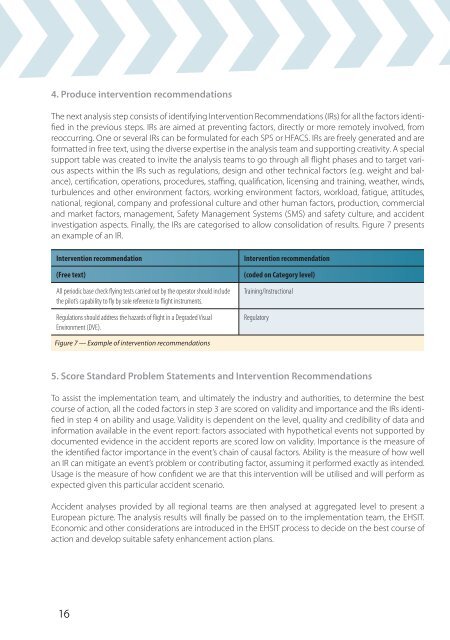Report - European Aviation Safety Agency - Europa
Report - European Aviation Safety Agency - Europa
Report - European Aviation Safety Agency - Europa
Create successful ePaper yourself
Turn your PDF publications into a flip-book with our unique Google optimized e-Paper software.
❯ ❯ ❯ ❯ ❯ ❯ ❯ ❯<br />
4. Produce intervention recommendations<br />
The next analysis step consists of identifying Intervention Recommendations (IRs) for all the factors identifi<br />
ed in the previous steps. IRs are aimed at preventing factors, directly or more remotely involved, from<br />
reoccurring. One or several IRs can be formulated for each SPS or HFACS. IRs are freely generated and are<br />
formatted in free text, using the diverse expertise in the analysis team and supporting creativity. A special<br />
support table was created to invite the analysis teams to go through all fl ight phases and to target various<br />
aspects within the IRs such as regulations, design and other technical factors (e.g. weight and balance),<br />
certifi cation, operations, procedures, staffi ng, qualifi cation, licensing and training, weather, winds,<br />
turbulences and other environment factors, working environment factors, workload, fatigue, attitudes,<br />
national, regional, company and professional culture and other human factors, production, commercial<br />
and market factors, management, <strong>Safety</strong> Management Systems (SMS) and safety culture, and accident<br />
investigation aspects. Finally, the IRs are categorised to allow consolidation of results. Figure 7 presents<br />
an example of an IR.<br />
Intervention recommendation Intervention recommendation<br />
(Free text) (coded on Category level)<br />
All periodic base check fl ying tests carried out by the operator should include<br />
the pilot’s capability to fl y by sole reference to fl ight instruments.<br />
Regulations should address the hazards of fl ight in a Degraded Visual<br />
Environment (DVE).<br />
Figure 7 — Example of intervention recommendations<br />
16<br />
Training/Instructional<br />
Regulatory<br />
5. Score Standard Problem Statements and Intervention Recommendations<br />
To assist the implementation team, and ultimately the industry and authorities, to determine the best<br />
course of action, all the coded factors in step 3 are scored on validity and importance and the IRs identifi<br />
ed in step 4 on ability and usage. Validity is dependent on the level, quality and credibility of data and<br />
information available in the event report: factors associated with hypothetical events not supported by<br />
documented evidence in the accident reports are scored low on validity. Importance is the measure of<br />
the identifi ed factor importance in the event’s chain of causal factors. Ability is the measure of how well<br />
an IR can mitigate an event’s problem or contributing factor, assuming it performed exactly as intended.<br />
Usage is the measure of how confi dent we are that this intervention will be utilised and will perform as<br />
expected given this particular accident scenario.<br />
Accident analyses provided by all regional teams are then analysed at aggregated level to present a<br />
<strong>European</strong> picture. The analysis results will fi nally be passed on to the implementation team, the EHSIT.<br />
Economic and other considerations are introduced in the EHSIT process to decide on the best course of<br />
action and develop suitable safety enhancement action plans.

















